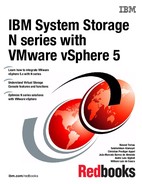Book Description
This IBM® Redbooks® publication provides a basic introduction to the IBM System Storage® N series, virtualization, and VMware 5.x. It explains how to use the N series with VMware vSphere 5 environments and the benefits of doing so. Examples are given on how to install and set up VMware ESXi server with the N series.
The IBM System Storage N series used as a storage foundation offers unified storage solutions that provide industry-leading technologies in the areas of storage efficiencies, instantaneous virtual machine and datastore cloning for virtual servers and virtual desktops, and virtual data center backup and business continuance solutions.
The information provided can be also be used as a foundation to create dynamic cloud solutions, making full use of underlying storage features and functions. This book provides a blueprint for how clients can create a virtualized infrastructure/storage cloud that will help to address current and future data storage business requirements.
IBM System Storage N series in conjunction with VMware vSphere 5 helps complete the virtualization hierarchy by providing both a server and storage virtualization solution.
Although this configuration can further assist with other areas of virtualization, networks, and applications, these areas of virtualization are not covered in detail in this book.
Table of Contents
- Front cover
- Notices
- Preface
- Chapter 1. Introduction to IBM System Storage N series
- Chapter 2. Introduction to virtualization
- Chapter 3. Benefits of N series with VMware vSphere 5.1
- 3.1 Increased protection with RAID-DP
- 3.2 Cloning virtual machines
- 3.3 Multiprotocol capability for storing files on iSCSI, SAN, or NFS volumes
- 3.4 N series LUNs for VMWare host boot
- 3.5 N series LUNs for VMFS datastores
- 3.6 Using N series LUNs for Raw Device Mappings
- 3.7 Growing VMFS datastores
- 3.8 Backup and recovery of virtual infrastructure (SnapVault, Snapshot, SnapMirror)
- 3.9 Using N series deduplication with VMware
- 3.10 Coupling deduplication and compression
- Chapter 4. Planning for N series and VMware vSphere 5.1
- Chapter 5. Installing the VMware ESXi 5.1 using N series storage
- Chapter 6. Installing and configuring VMware vCenter 5.1
- Chapter 7. Presenting N series storage for VMware vSphere 5.1
- 7.1 Preparing N series LUNs for VMware vSphere
- 7.2 Adding licenses to N series systems
- 7.3 Setting up thin provisioning
- 7.4 Presenting LUNs to an ESXi server over Fibre Channel
- 7.5 Using N series LUNs for Raw Device Mapping
- 7.6 Creating a VMKernel portgroup on VMware vSphere 5.1
- 7.7 Presenting LUNs to VMware ESXi Server over iSCSI protocol
- 7.8 Creating a datastore cluster
- 7.9 Presenting an iSCSI LUN directly to a virtual machine
- 7.10 NFS volumes on VMware vSphere 5.1
- 7.11 Monitoring and management
- 7.12 Storage growth management
- Chapter 8. N series cloning
- Chapter 9. Configuring snapshots
- Chapter 10. Recovery options
- Chapter 11. Backup and recovery to a separate system
- Chapter 12. High availability and disaster recovery
- 12.1 High availability
- 12.2 Disaster recovery options
- 12.3 Setting up disaster recovery
- 12.4 Recovering from a disaster
- 12.5 Returning to production
- 12.5.1 Replicating data from disaster recovery to the production site
- 12.5.2 Preventing access and performing a final update
- 12.5.3 Splitting the mirror
- 12.5.4 Re-establishing the mirror from the production to disaster recovery site
- 12.5.5 Configuring VMware hosts and virtual machines on the production site
- 12.6 Disaster recovery testing
- Chapter 13. Deduplication / Compression with VMware vSphere 5.1
- Chapter 14. Virtual Storage Tiering
- Chapter 15. Virtual Storage Console 4.1
- 15.1 Virtual Storage Console
- 15.2 Installing the Virtual Storage Console 4.1
- 15.3 Adding storage controllers to the VSC
- 15.4 Optimal storage settings for ESXi host
- 15.5 SnapMirror integration
- 15.6 VSC in an N series MetroCluster environment
- 15.7 Backup and recovery
- 15.8 Provisioning and cloning
- 15.9 Optimum VM availability
- 15.10 VSC commands
- 15.11 Scripting
- Related publications
- Back cover
